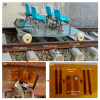Collaborative Damage Detection Framework for Rail Structures Based on a Multi-Agent System Embedded with Soft Multi-Functional Sensors
- PMID: 36298145
- PMCID: PMC9610417
- DOI: 10.3390/s22207795
Collaborative Damage Detection Framework for Rail Structures Based on a Multi-Agent System Embedded with Soft Multi-Functional Sensors
Abstract
With the rapid growth of railways in China, the focus has changed to the maintenance of large-scale rail structures. Multi-agent systems (MASs) based on wireless sensor network (WSNs) with soft multi-functional sensors (SMFS) are adopted cooperatively for the structural health monitoring of large-scale rail structures. An MAS framework with three layers, namely the sensing data acquisition layer, sensor data processing layer, and application layer, is built here for collaborative data collection and processing for a rail structure. WSN nodes with strain, temperature, and piezoelectric sensor units are developed for the continuous structural health monitoring of the rail structure. The feature data at different levels are extracted for the online monitoring of the rail structure. Experiments carried out at the Rail Transmit Base at East China Jiaotong University verify that the WSN nodes with SMFS are successfully assembled onto a 100-m-long track for damage detection. Based on the sensing data and feature data, a neural network data fusion agent (DFA) is applied to calculate the damage index value of the track for comprehensive decisions regarding rail damage. The use of WSNs with multi-functional sensors and intelligent algorithms is recommended for cooperative structural health monitoring in railways.
Keywords: damage detection; multi-agent system; soft multi-functional sensors; structural health monitoring; wireless sensor network.
Conflict of interest statement
The authors declare no conflict of interest.
Figures
















Similar articles
-
Symbolic and graphical representation scheme for sensors deployed in large-scale structures.Sensors (Basel). 2013 Jul 31;13(8):9774-89. doi: 10.3390/s130809774. Sensors (Basel). 2013. PMID: 23912426 Free PMC article.
-
Advanced UAV-WSN System for Intelligent Monitoring in Precision Agriculture.Sensors (Basel). 2020 Feb 3;20(3):817. doi: 10.3390/s20030817. Sensors (Basel). 2020. PMID: 32028736 Free PMC article.
-
A structure fidelity approach for big data collection in wireless sensor networks.Sensors (Basel). 2014 Dec 25;15(1):248-73. doi: 10.3390/s150100248. Sensors (Basel). 2014. PMID: 25609045 Free PMC article.
-
A Survey of Collaborative UAV-WSN Systems for Efficient Monitoring.Sensors (Basel). 2019 Oct 28;19(21):4690. doi: 10.3390/s19214690. Sensors (Basel). 2019. PMID: 31661937 Free PMC article. Review.
-
Review on the Traction System Sensor Technology of a Rail Transit Train.Sensors (Basel). 2017 Jun 11;17(6):1356. doi: 10.3390/s17061356. Sensors (Basel). 2017. PMID: 28604615 Free PMC article. Review.
References
-
- Jing L., Wang K., Zhai W. Impact vibration behavior of railway vehicles:a state-of-the-art overview. Acta Mech. Sin. 2021;37:30. doi: 10.1007/s10409-021-01140-9. - DOI
-
- Liu G., Li P., Wang P., Liu J., Wei X. Study on structural health monitoring of vertical vibration of ballasted track in high-speed railway. J. Civ. Struct. Health Monit. 2021;11:451–463. doi: 10.1007/s13349-020-00460-x. - DOI
-
- Gj A., Ms A., Jre B., Msd B., Nah C. Smart railway sleepers-a review of recent developments, challenges, and future prospects-ScienceDirect. Constr. Build. Mater. 2020;271:121533.
-
- Lai J., Xu J., Liao T., Zheng Z., Chen R., Wang P. Investigation on train dynamic derailment in railway turnouts caused by track failure. Eng. Fail. Analysis. 2022;134:106050. doi: 10.1016/j.engfailanal.2022.106050. - DOI
-
- Skrypnyk R., Ossberger U., Plsson B.A., Ekh M., Nielsen J. Long-term rail profile damage in a railway crossing: Field measurements and numerical simulations. Wear. 2020;472–473:203331. doi: 10.1016/j.wear.2020.203331. - DOI
MeSH terms
Grants and funding
LinkOut - more resources
Full Text Sources

